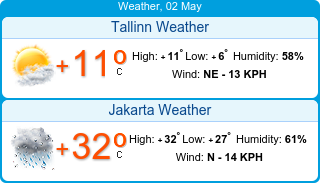Estonia’s Blue-Black-White Tricolour Flag
The blue-black-white tricolour has been adopted by the Estonian people, and has become the most important and loved national symbol. The tricolour has been one of the most important factors in the independence, consciousness and solidarity of the Estonian people.
The idea of the blue-black-white colour combination was born from the Estonian Awakening Period at the founding of the "Vironia" Society (now Eesti Üliõpilaste Selts, Estonian Students Society) on 29 September 1881.
The first blue-black-white flag was made in the spring of 1884. Since appearances with this flag were banned in Tartu, the flag was blessed on 4 June 1884 in Otepää. The last song of the service was "Mu isamaa, mu õnn ja rõõm" (My Native Land, My Pride and Joy, the current national anthem).
The beginning of the 20th century was a period where the flag gained more national importance. Numerous houses were decorated with national flags the day before the VII Song Festival in 1910 until local authorities demanded the removal of the flags.
The blue-black-white flags of Estonian Student organisations and Estonian soldier groups were waived at the large Estonian manifestation and parade demanding Estonian autonomy in Petrograd in 1917. Following this manifestation, Estonia was the only country that was granted autonomy by Imperial Russia. After the new autonomy, soldiers and citizens were seen wearing tricolour badges and ribbons.
On 24 February 1918, accompanied by the blue-black-white tricolour, Estonia declared its independence. The provisional Government of the Republic of Estonia declared the blue-black-white tricolour the official Estonian National Flag on 21 November 1918. The flag was raised for the first time as a national symbol at the Pikk Hermann Tower in Tallinn on 12 December 1918.
Following the occupation of Estonia by Soviet forces in 1940, Estonia’s national symbols were forcibly replaced by Soviet symbols. The raising of the Estonian flag or even the possession of the tricolour was considered a crime for which some people were even sent to prison camps or killed. Expatriate Estonian organisations and societies must be commended for upholding the honour of the Estonian National Flag during the difficult period of Soviet occupation. The 100th anniversary of the Estonian Flag was celebrated in exile. The Singing Revolution of the late 1980s paved the way for the raising of the blue-black-white Estonian flag to the top of the Pikk Hermann tower on 24 February 1989.
Since 2004 the Estonian tricolour flies together with the national flags of other European Union and NATO Member States.
Honorary Consul of the Republic of Estonia
Special Capital District of Jakarta
Jl. Pinang Emas III/17, Pondok Indah
Jakarta 12310, INDONESIA
Phone. 0812 199 4488
This email address is being protected from spambots. You need JavaScript enabled to view it.
www.consulateestoniajakarta.com
Office hours: 08:00 a.m to 01:00 p.m
Appointment with Consul (H)
Youtube: Adriana Sri Lestari

































